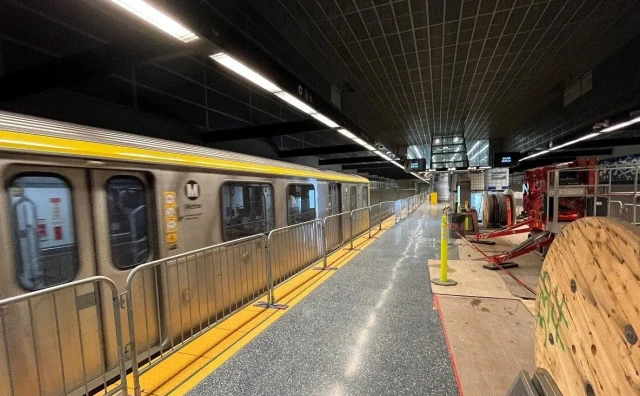With our free press under threat and federal funding for public media gone, your support matters more than ever. Help keep the LAist newsroom strong, become a monthly member or increase your support today during our fall member drive.
This archival content was written, edited, and published prior to LAist's acquisition by its current owner, Southern California Public Radio ("SCPR"). Content, such as language choice and subject matter, in archival articles therefore may not align with SCPR's current editorial standards. To learn more about those standards and why we make this distinction, please click here.
Photos: This Zoning-Themed Mini-Golf Course Tackles Housing Issues In L.A.
The Los Angeles Poverty Department has been using art to take on civic issues for more than three decades, and the latest project from the Skid Row-based nonprofit is no exception.
Zoning, or the process of dividing land into different uses with different rules, may seem dry, but it quite literally shapes our cities. The process is often opaque to non-planners, and most citizens have little idea of how much power lies within zoning codes. The Back 9, a zoning-themed playable miniature golf course designed by Rosten Woo, in collaboration with LAPD (yes, the Los Angeles Poverty Department also goes by LAPD, and yes, they are in on the joke), aims to demystify the process and interrogate the mechanisms, hidden assumptions and consequences of the now-in-progress re-zoning of Los Angeles.
“Zoning changes how wealth is accumulated, but it’s very technical and opaque. One goal is to help people understand what it is, what it does, and how they can have input,” artist Rosten Woo told the LA Downtown News. “But the second part is that people need to see the end result, what the stakes are. There are implications for social class.”
The multidisciplinary art project, which was made possible by a grant from the Mike Kelley Foundation for the Arts, essentially uses each hole in the course to explain a part of the zoning process. Los Angeles was a national pioneer in zoning laws (we passed the nation's first citywide zoning ordinance separating residential areas from other uses in 1908) and is now in the midst of updating our zoning codes as part of the Re:Code LA initiative. To the artist-activists at the LAPD, zoning is also seen as a tool of oppression: in their view, L.A. has been "particularly effective at wielding these codes as a means for disenfranchising communities, historically handing over an extraordinary amount of control to the city’s developers."
“The back nine is a colloquial expression of a place where deals happen,” LAPD artistic director John Malpede told the L.A. Times. In Malpede's view, golf is the perfect metaphor for the behind-the-scenes dealings that often dictate development in L.A., or what he calls the “the process that happens behind the public process.”
While the mini-golf course is "a response to the re-zoning of Los Angeles (now in process), it has additional resonance in the current moment: a time when Golf is at the center of Trumpian world politics," according to a statement from the organization.
"The Back 9 is an excellent example of how art can reflect and perhaps ultimately impact our communities. A golf course—with all its timely connotations— is an inventive way to stage an examination of the consequences of rezoning a city," Mike Kelley Foundation for the Arts Executive Director Mary Clare Stevens told LAist. "The installation and performances demand engagement and attention, and the Los Angeles Poverty Department and Rosten trust that their audience is up to the challenge of responding to the ideas and themes presented. We are thrilled to support the project.”
The Back 9 which opened on June 10, is housed at LAPD's Skid Row History Museum & Archive on S. Broadway just north of Grand Central Market. There will be a performances at the installation on June 16 (8 p.m.) and June 17 (3 p.m.), and the installation will run through October 28.
The Skid Row History Museum & Archive is located at 250 S. Broadway in downtown Los Angeles. (213) 413-1077
At LAist, we believe in journalism without censorship and the right of a free press to speak truth to those in power. Our hard-hitting watchdog reporting on local government, climate, and the ongoing housing and homelessness crisis is trustworthy, independent and freely accessible to everyone thanks to the support of readers like you.
But the game has changed: Congress voted to eliminate funding for public media across the country. Here at LAist that means a loss of $1.7 million in our budget every year. We want to assure you that despite growing threats to free press and free speech, LAist will remain a voice you know and trust. Speaking frankly, the amount of reader support we receive will help determine how strong of a newsroom we are going forward to cover the important news in our community.
We’re asking you to stand up for independent reporting that will not be silenced. With more individuals like you supporting this public service, we can continue to provide essential coverage for Southern Californians that you can’t find anywhere else. Become a monthly member today to help sustain this mission.
Thank you for your generous support and belief in the value of independent news.

-
Metro officials said it will be able to announce an opening date “soon.”
-
While working for the county, the DA’s office alleges that 13 employees fraudulently filed for unemployment, claiming to earn less than $600 a week.
-
The L.A. County Board of Supervisors on Tuesday voted to declare immigration enforcement actions a local emergency.
-
Tens of thousands of workers across Southern California walk out over pay and staffing issues.
-
People in and around recent burn scars should be alert to the risk of debris flows. Typical October weather will be back later this week.
-
Jet Propulsion Laboratory leadership says the cuts amount to 11% of the workforce.







